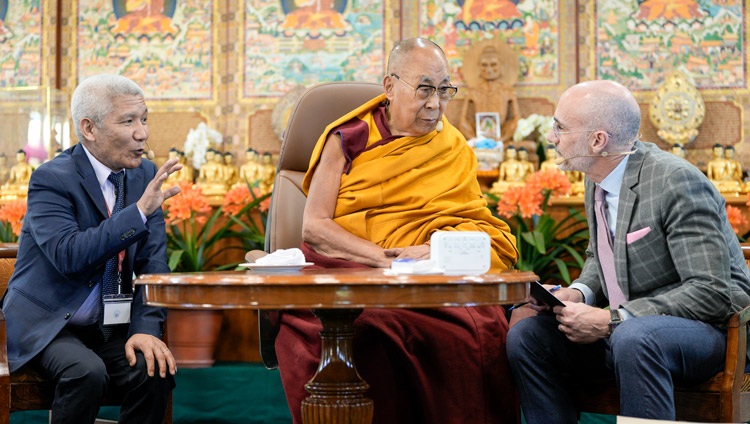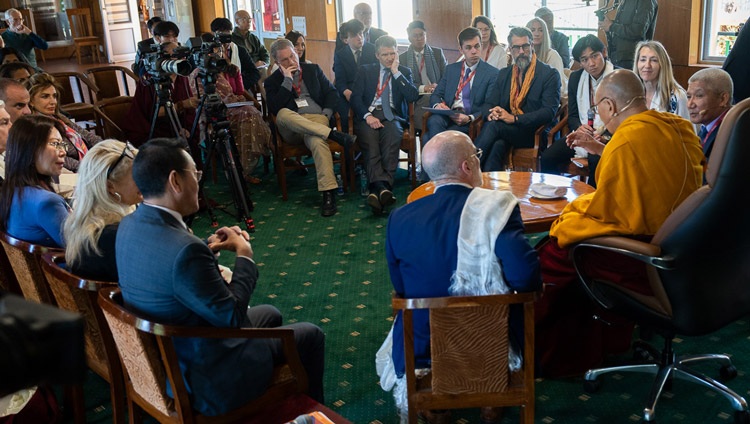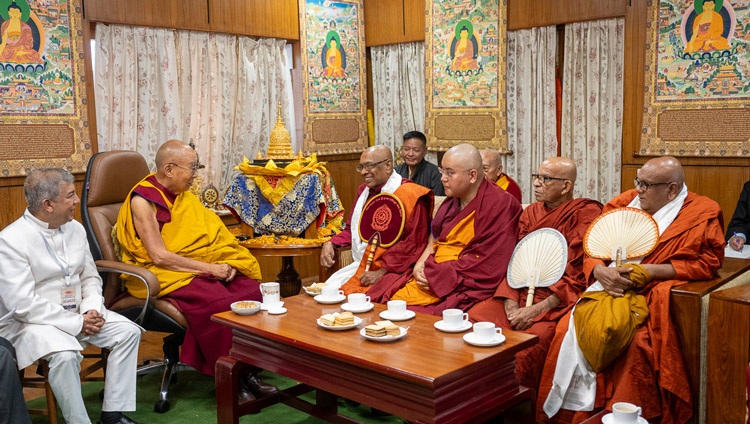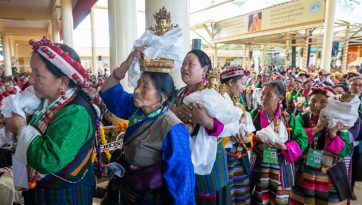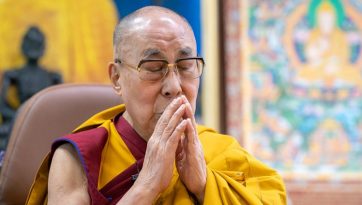Commentary on the Awakening Mind – First Day
November 5, 2020
Thekchen Chöling, Dharamsala, HP, India – This morning’s session began with Telo Rinpoché, who is His Holiness the Dalai Lama’s representative in Russia, Mongolia and CIS countries, thanking His Holiness for teaching groups of Russians in general since 2009 and for teaching them in Riga, Latvia since 2014. He rejoiced that, despite the pandemic, due to the technology we have today, it’s possible for a group like this to gather over the internet.
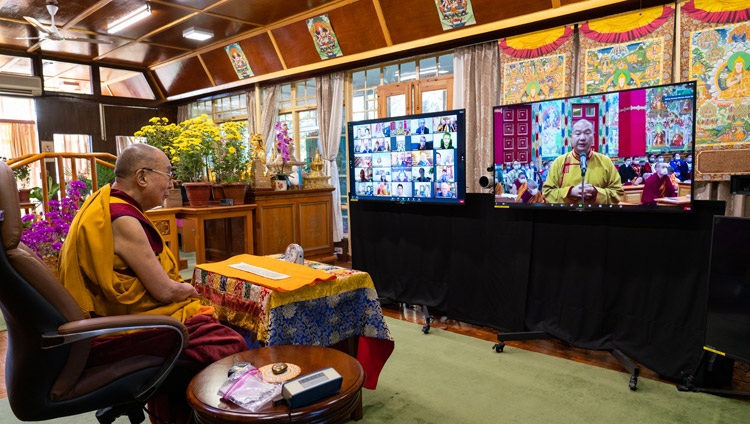
Telo Rinpoché explained there would first be a recitation of the ‘Heart Sutra’ from Kuntse Choinoei Datsang in St Petersburg, which was built on the initiative of Tsenshab Ngawang Dorje, with contributions from the 13th Dalai Lama and Buddhists from Mongolia and across Russia. Rinpoché mentioned that the second ‘Heart Sutra’ recitation would be in the Buryati language from Rinpoche Bagsha Datsang in Ulaan Udé.
Once these recitations of the ‘Heart Sutra’ were complete, His Holiness addressed the audience.
“Devotees in the Russian Republics, we are able to meet virtually today via video link. We Tibetans have had links with people from Kalmykia, Buryatia and Tuva for centuries. In 1959, when I sat for my Geshé exams there were many Geshés from these republics who debated with me. Among them were Khensur Ngawang Lekden, Abbot Thupten Nyima from Buryat and Geshé Yangdak from Tuva, who I believe spoke Russian well. So, during my lifetime there were top scholars like these, and we referred to them generally by the name ‘Sokpo’.
“Ngodup Tsoknyi from Inner Mongolia was one of my teachers. He introduced me to the view of emptiness.
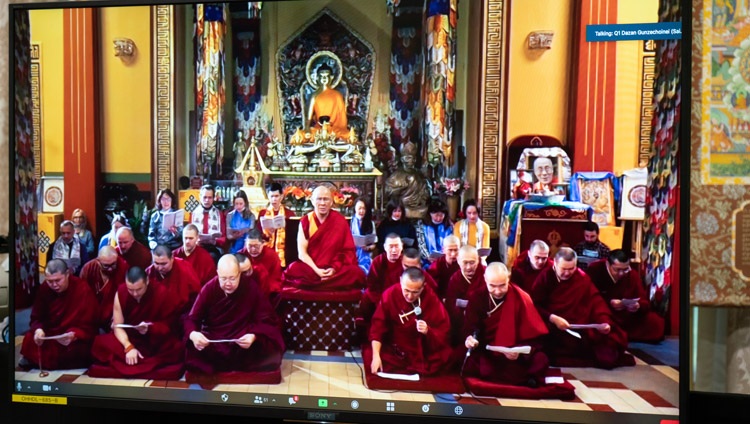
“Tibetans and people of Mongolian ethnicity have had connections for generations. Sadly, during the revolutions in Mongolia and later in China, many great scholars were executed. One was tutor to Kunkhyen Jamyang Shayba. It seems he was executed for the crime of having many disciples. When he was about to die, he asked for a moment to say a prayer. And what he prayed was, ‘O my guru, please bless me that the ill-deeds of sentient beings bear fruit for me and all my virtues bear fruit for them’. What happened in Russia and Mongolia later took place in Tibet as well.
“Authorities tried to eliminate the dharma, but it can’t be eliminated by force because as long as we have feelings, we all wish to be happy and not to suffer. As human beings we are intelligent and have the ability to think things through. We can use our minds to change how we think to cultivate happiness and reduce suffering. The dharma and religion in general are a means to transform our minds.
“In India there were two phases for the dissemination of the Buddha’s teachings, one has become the Pali Tradition and the other the Sanskrit Tradition. In Tibet and the Mongolian regions, we follow the Nalanda Tradition, which emphasizes the use of logic and critical analysis. The Buddha encouraged his followers to take this approach when he told them: ‘As the wise test gold by burning, cutting and rubbing it, so, bhikshus, should you accept my words — only after testing them, and not merely out of respect for me’.
“Like his Six Collections of Reason, this ‘Commentary on the Awakening Mind’ by Nagarjuna relies on reason and logic.
“The Buddha predicted that his teaching would spread from north to north, which is interpreted as meaning that it would first travel to Tibet and then on to the Mongolian regions. We follow the Nalanda Tradition that Shantarakshita introduced to Tibet. He was the author of a ‘Compendium of Reality’ dealing with logic and epistemology and ‘Ornament of the Middle Way’, which is a philosophical text. He is also regarded as the founder of the Practitioners of Yogic Conduct Autonomist Middle Way School (Yogachara Svatantrika Madhyamaka).
“Buddhism was introduced to Mongolia from Tibet at the time of Chögyal Phagpa. Later, many Mongolians became disciples of the Third Dalai Lama and the Geluk tradition spread widely. His name was Sonam Gyatso, and Dalai, meaning ocean, is a Mongolian equivalent of Gyatso.
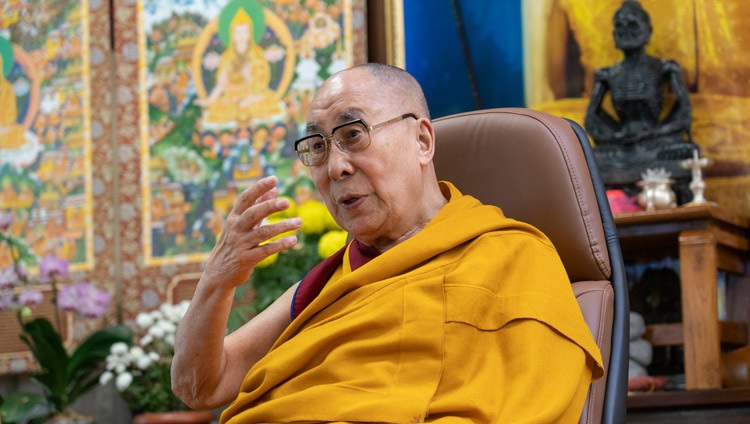
“In 1979, I was able to visit Russia and to go on to Mongolia. I sat with a group of old monks inside Gandan Monastery in Ulaanbaatar. They made a long-life offering to me during which they chanted with such devotion it brought tears to their and my eyes. I reflected on how Buddhism had spread there and how it had been destroyed — and yet faith was undiminished. The atrocities of the Russian and Chinese revolutions could not erase faith from people’s minds.”
His Holiness spoke of the Abbots’ and older monks’ reluctance when he suggested introducing modern science to the Tibetan monasteries re-established in South India. He pointed out that there were things monastic scholars could explain to scientists as well as learning from them. He observed that these days he is known for his interest in science as well as his Buddhist training. He remarked that he respects all religious traditions and is happy to pay his respects at their places of worship, but his personal faith remains with the Buddha.
Scientists born and brought up in the West have only a cursory understanding of the mind and emotions, which Buddhists can explain in detail. Consequently, there are scientists today taking an interest in what the Buddha taught. Meanwhile, scientific laboratories have been established in places like Drepung Loseling Monastery. Training in the Nalanda Tradition has prepared monks for engaging with and learning from modern scientists.
Although many monastic institutions in the Mongolian regions and Tibet were destroyed, a revival is underway. His Holiness remarked that communists tried to brain-wash people about alleged drawbacks of Buddhism, but in vain. However, he stressed that if the tradition is to survive, it’s necessary to study and practise. Buddhist practice is not limited to setting up an altar and paying respect to the images and scriptures installed on it. The reason the Kangyur and Tengyur collections are worthy of respect is that they are textbooks for the study of the Buddha’s teachings.
“I’ve been encouraging Tibetans to study,” His Holiness declared, “and I advise you to do the same. When it comes to the ‘Treasury of Knowledge’ (Abhidharmakoshakarika) you can leave chapter three closed because it discusses cosmology in terms that are no longer consistent with scientific observations. However, what the book has to tell us about the mind and emotions is still valuable. Books belonging to the Perfection of Wisdom reveal how to progress on the path to enlightenment. Maitreya’s ‘Ornament for Clear Realization’ mentions ten instructions touching on the two truths, the four truths and the objects of refuge.
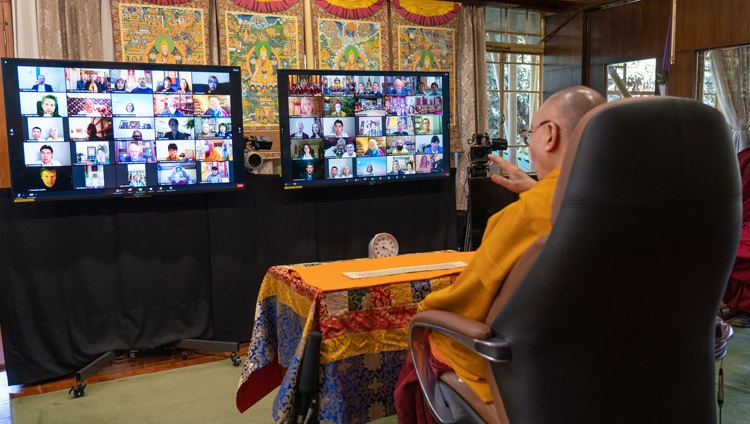
“Nagarjuna’s Six Collections of Reasoning clarify what is presented in the Perfection of Wisdom. Chandrakirti’s ‘Entering into the Middle Way’ is an excellent text in the same vein. I’m particularly fond of verses 34-36 of Chapter Six which makes clear that nothing whatever has any intrinsic existence in and of itself. I regularly repeat these verses to myself and reflect on them.
If the intrinsic characteristics of things were to arise dependently,
things would come to be destroyed by denying it;
emptiness would then be a cause for the destruction of things.
But this is illogical, so no real entities exist. 6.34
Thus, when such phenomena are analysed,
nothing is found as their nature apart from suchness.
So, the conventional truth of the everyday world
should not be subjected to thorough analysis. 6.35
In the context of suchness, certain reasoning disallows arising
from self or from something other, and that same reasoning
disallows them on the conventional level too.
So, by what means then is your arising established? 6.36
“‘Entering into the Middle Way’ further states that all negative emotions arise as a result of grasping at true existence. The ‘Four Hundred Verses’ too states that ignorance is the root of all mental afflictions, but if you develop an understanding of dependent arising, you can overcome it. We experience attachment and anger because of our misconception that things have some objective existence in and of themselves. When we examine distorted states of mind like anger and attachment, we find they have no sound basis.
“What I’m aspiring to do is reach the true cessation described in Chapter Six of ‘Entering into the Middle Way’. Liberation can be obtained by developing an understanding of emptiness. And even if you don’t aspire for liberation, an understanding of emptiness helps counter suffering.
Thus, illuminated by the rays of wisdom’s light,
the bodhisattva sees as clearly as a gooseberry on his open palm
that the three realms in their entirety are unborn from their very start,
and through the force of conventional truth, he journeys to cessation. 6.224
His Holiness turned to the text he was going to teach: Nagarjuna’s ‘Commentary on the Awakening Mind’. He read the line of homage to Vajrasattva and noted that the first preliminary verse comes from Guhyasamaja Tantra. It refutes the self posited by non-Buddhists, that is a self the exists independently of the psycho-physical aggregates. He mentioned that the Mind Only School accept the objective existence of things, but reject their external existence. They assert a ‘foundational consciousness’ as the basis of self. Followers of the Middle Way, on the other hand, reject any intrinsic existence in things at all.
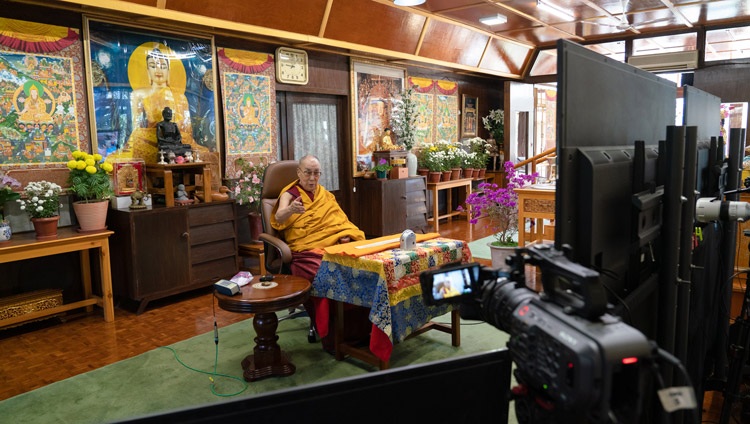
His Holiness drew attention to a verse in ‘Fundamental Wisdom of the Middle Way’ that discusses the Tathagata.
Not one with the aggregates, not separate from them,
[He] is not based on them, nor are they on [him],
The Tathagata does not possess the aggregates:
Who, then, is the Tathagata?
He revealed that by reworking the words he goes on to apply the verse to himself and repeats it as follows:
Not the aggregates, nor separate from them,
[I am] not based on them, nor they on [me];
[I] do not possess the aggregates.
Who, then, am I?
“Understanding that nothing whatsoever has any objective existence needs to be combined with the altruistic intention to become enlightened in order to benefit all beings. Verses from Shantideva’s ‘Guide to the Bodhisattva’s Way of Life’ indicate the crucial significance of this intention.
All those who suffer in the world do so because of their desire for their own happiness. All those happy in the world are so because of their desire for the happiness of others. 8/129
Why say more? Observe this distinction: between the fools who long for their own advantage and the sage who acts for the advantage of others. 8/130
For those who fail to exchange their own happiness for the suffering of others, Buddhahood is certainly impossible – how could there even be happiness in cyclic existence? 8/131
“As scientists observe, we are social beings. Love and concern for others arise naturally within us.”
His Holiness pointed out that the Buddha first taught a coarse selflessness of persons, but later disclosed a subtle non-duality of subject and object. The Consequentialists (Prasangikas) who represent the highest view assert no objective existence whatever. He read the second preliminary verse:
Just as the blessed Buddhas and the great bodhisattvas have generated the mind of great awakening, I too shall, from now until I arrive at the heart of awakening, generate the awakening mind in order that I may save those who are not saved, free those who are not free, relieve those who are not relieved, and help thoroughly transcend sorrow those who have not thoroughly transcended sorrow.
He commented that through understanding emptiness alone it is possible to become an arhat or solitary buddha. In order to achieve the complete enlightenment of a Buddha, this understanding must be combined with the awakening mind. Only by this means can cognitive obscurations be overcome.
His Holiness then read steadily through the first 26 verses of the text.
While answering questions from the audience His Holiness clarified that the two methods for generating the awakening mind, the sevenfold cause and effect approach and the method of equalizing and exchanging self and others are not contradictory. The first is a more gradual approach. The second is more suited to people with sharper faculties. Regardless of which approach you adopt, the more altruistic you are, the happier you’ll be.
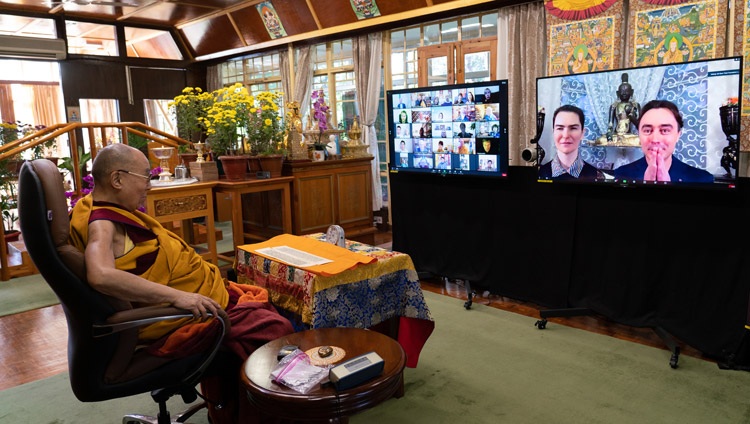
His Holiness acknowledged that we have a sense of ‘I’ that is designated on the basis of the mind. He quoted the Guhyasamaja Tantra as stating that the innermost clear light mind is the fundamental basis for the designation of self. There is no difference between the clear light of the Buddha’s mind and our own. Similarly, there is no difference between the emptiness of the Buddha’s mind and the emptiness of our own. When we recognise our Buddha nature through practice, we’ll finally become Buddhas.
Highest Yoga Tantra says that the quick path to enlightenment is based on realizing the clear light nature of the mind. The ultimate awakening mind refers to the mind that realizes emptiness directly. However, the ‘rigpa’ mentioned in the Great Perfection teachings (Dzogchen) refers to having an experience of the clear light nature of the mind itself, that is, making it manifest within us.
After his enlightenment the Buddha is said to have thought — ‘Profound and peaceful, free from elaboration, uncompounded luminosity — I have found a nectar-like Dharma. Yet if I were to teach it, no-one would understand, so, I shall remain silent here in the forest.’ His Holiness suggested that the words ‘profound and peaceful’ refer the Buddha’s first round of teachings. ‘Free from elaboration’ refers to emptiness as it was revealed in the perfection of wisdom teachings of the second round. ‘Uncompounded luminosity’ refers to Buddha nature, the mind of clear light, explained in the third round.
Highest Yoga Tantra emphasizes the subjective clear light of the mind. The Perfection of Wisdom teachings focus on emptiness, the object clear light. His Holiness remarked that sometimes, in talking about the Great Seal and the Great Perfection, (Mahamudra and Dzogchen), some people seem to neglect the object clear light — emptiness — and only pay attention to the subjective clear light.
In discussing coarse and subtle minds, His Holiness cited the example of people whose bodies remain fresh even after clinical death. This is because, due to their meditative experience, the subtlest consciousness, their subtle clear light mind, has remained in the body. He acknowledged that American and Russian scientists are investigating this phenomenon.
His Holiness distinguished coarse and subtle levels of impermanence. Physical death is a coarse aspect. Momentary change, which is continuous because nothing remains static, is subtle impermanence. He clarified that the five ever-present mental factors — contact, feeling, perception, volition and attention accompany any moment of mind and always occur together.
With regard to helping loved ones who are sick, especially during this pandemic, His Holiness recommended examining whether there is anything to be done and if there is, to do it. If there are no steps to be taken, giving in to worry will not make things better.
Asked to reconcile the prevailing sense of freedom of speech in Europe with the apparent dogmatism of some individuals, His Holiness expressed admiration for the idea of a union of nations embodied by the European Union and suggested that it be extended to other parts of the world as a mature way to manage relations.
As His Holiness thanked his audience, today’s session came to an end. His explanation of the ‘Commentary on the Awakening Mind’ will continue tomorrow.
SOURCE: https://www.dalailama.com/news/2020/commentary-on-the-awakening-mind-first-day




